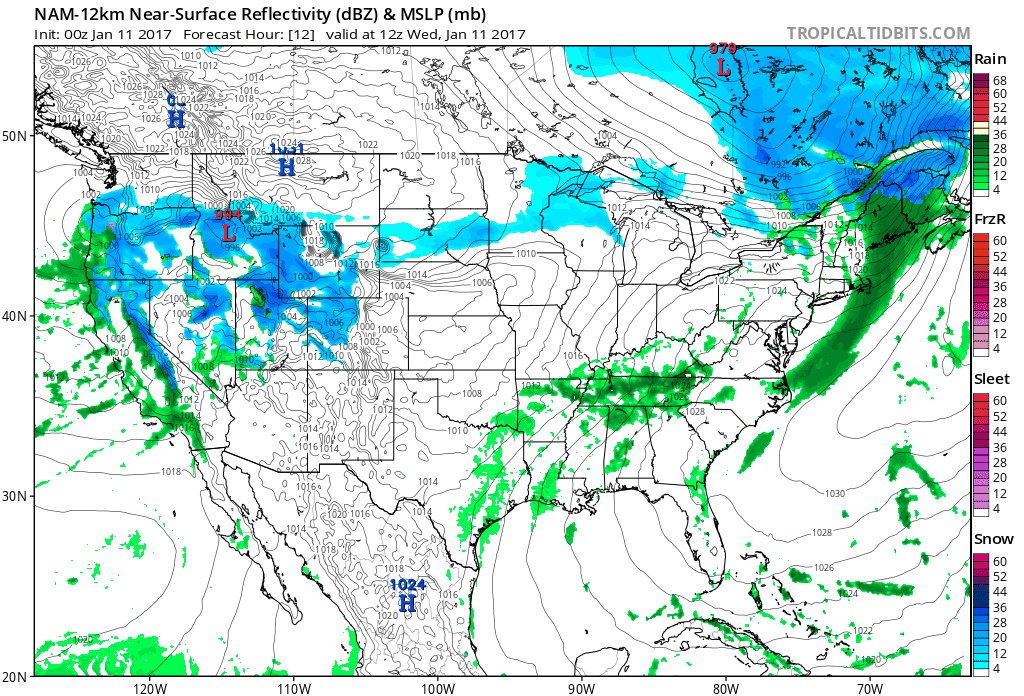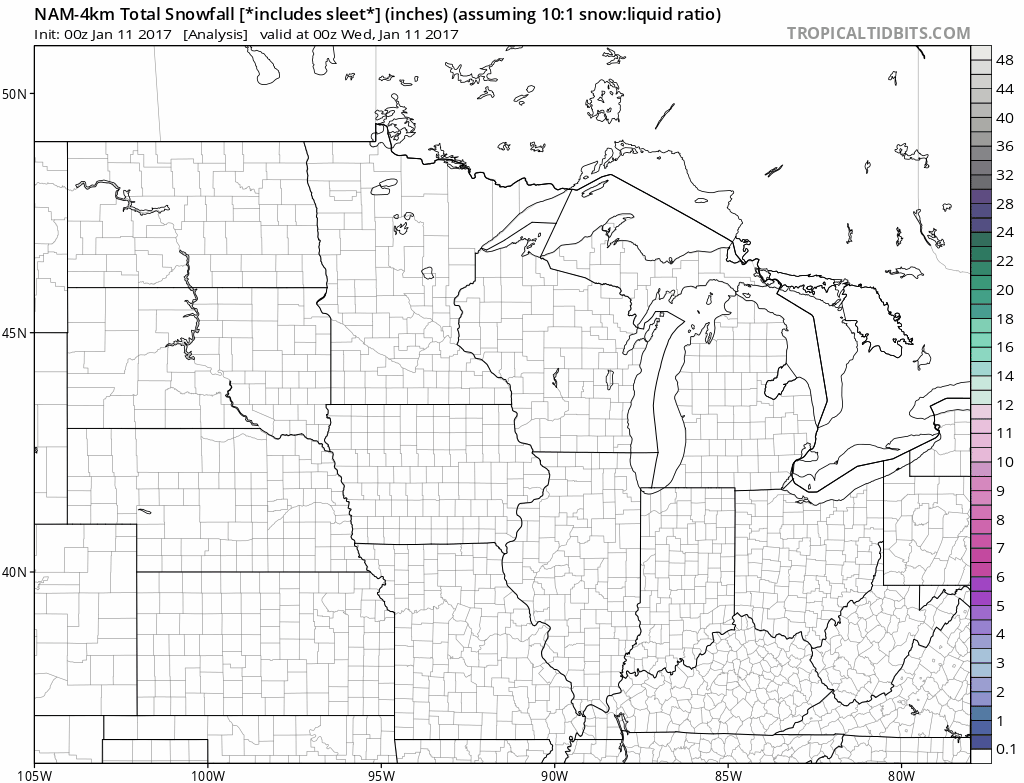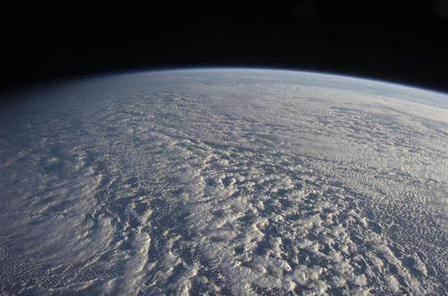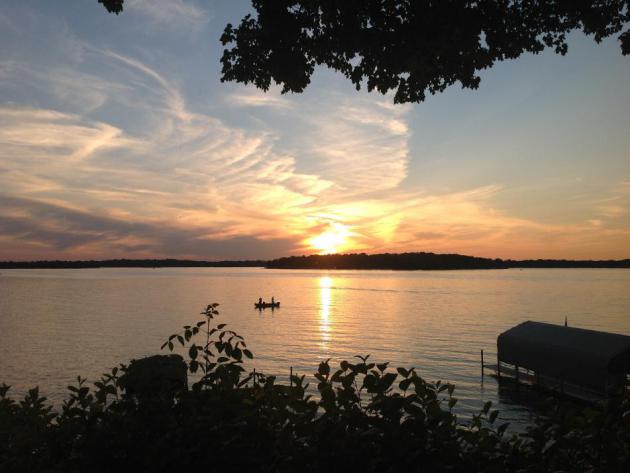24 F. high temperature in St. Cloud on Monday.
21 F. average high on January 10.
-1 F. maximum temperature on January 10, 2016.
January 11, 1975: A blizzard continues with hurricane force winds in southwestern Minnesota.
January 11, 1899: An odd flash of lightning lights the clouds up around 9 pm at Maple Plain.
Forecast: Another White-Knuckle Commute Today
For almost 30 years I've talked about the "Hassle Factor". It's not enough to tally up how much snow will fall. When will it fall, how cold is the snowfall, will it be compacted into an impassable layer of ice before rush hour?
It's a complicated matrix of factors that determine how dreadful the impacts will be. An inch of snow at 6 AM on a workday with an air temperature of 15F creates far more problems than 6 inches of snow at 9 PM with a temperature of 30F.
According to the Minnesota DNR's "Winter Misery Index", which factors intensity and duration of cold and snowfall, this winter still falls into the "mild" category. The MSP metro has enjoyed 11 nights below zero so far - average for an entire winter is close to 30 nights.
No worries - be happy!
The arrival of a new Canadian Treat sets off a couple inches of powdery snow this morning. With single digit temperatures the result should be more slipping and sliding. You'll be satisfying numb on Friday, but a slushy warm front arrives next week with a string of 30s.
Keep expectations low and you may even be pleasantly surprised!
Keep Your Pets Warm and Healthy This Winter Season. An article at High Plains Journal has some very good advice: "Just because they have a fur coat does not mean your pet can endure extended time outdoors when the temperature is frigid. Dogs, like other animals, must be out of the wind and dry for the insulating properties of their coats to be effective. Dogs that evolved in warm climates have short hair coats to protect them from the sun and help them stay cool, versus dogs that evolved in cold climates and have longer hair coats. If you are cold, your short-haired pet may be cold, too. Just as people add extra layers of clothing, bump up the thermostat or throw an extra log on the fire to keep warm, pet owners must take action to ensure their four-legged friends stay warm and healthy through the winter season..."

California Firehose; More Light Snow Upper Midwest. Stare at this animation long enough and you will become hypnotized. There's a fair amount of rain (depicted in green) in the 84-hour 12 KM NAM model guidance, considering the next week to 10 days is just about the coldest of the year for most American cities. California, afflicted with flooding rains and ridiculous mountain snowfall totals (above 10,000 feet) doesn't really dry out until Friday. An area of light snow tracks across Minnesota and Wisconsin today; ice for Madison, but mostly rain for the Ohio Valley on south and east. Source: Tropicaltidbits.com.
 Not Quite as Dramatic as Monday.
Yes, 3-4" was a subtle (yet blunt) reminder that it can still snow,
even though that means the traffic report will last 48 minutes. A series
of weak, clipper-like swirls of low pressure rippling along the
eastward push of colder air may drop a couple more inches of snow today
with flurries returning Thursday morning. Stuff stops falling from the
sky on Friday as a bubble of Canadian high pressure drifts overhead. 4
KM NAM snowfall totals: NOAA and Tropicaltidbits.com.
Not Quite as Dramatic as Monday.
Yes, 3-4" was a subtle (yet blunt) reminder that it can still snow,
even though that means the traffic report will last 48 minutes. A series
of weak, clipper-like swirls of low pressure rippling along the
eastward push of colder air may drop a couple more inches of snow today
with flurries returning Thursday morning. Stuff stops falling from the
sky on Friday as a bubble of Canadian high pressure drifts overhead. 4
KM NAM snowfall totals: NOAA and Tropicaltidbits.com.What Is An Atmospheric River? Weather Phenomenon Hits California, Nevada with Rain, Snow and Flooding. A few interesting nuggets from International Business Times: "A not-entirely-unwelcome storm dumped heavy rain on parts of California and Nevada Sunday during part of a weather phenomenon known as an atmospheric river. Another followed close on its tail and was expected to bring up to 15 inches of rain in places like the Sierra Nevada mountains Monday. Atmospheric rivers are actually common weather patterns that occur all over the world. The term is used to describe narrow portions of the atmosphere that hold water vapor and bring rain, wind and snow as they travel. At any given moment, an atmospheric river is depositing rain or snow somewhere, according to the National Oceanic and Atmospheric Administration. Anywhere between 30 to 50 percent of the annual precipitation that occurs on the West Coast of the United States is caused by atmospheric rivers..."
Infographic credit: NOAA.
December 2016: Really Cold, Really Warm, Nearly Average. The Minnesota DNR has a very good recap highlighting just how manic last month was: -20F on December 18. One week later nearly an inch of RAIN on Christmas Day! Here's an excerpt: "...Minnesotans are used to large variations in temperatures, but December 2016 was notable for its long streaks of warm and cold conditions: the temperatures only switched from one side of average to another two times during the month. The result of these long stretches of seemingly opposite conditions was that the month ended up pretty close to average--slightly warmer in most locations, making it 16 straight warm months Twin Cities. December was also wet enough to help the Twin Cities break its all-time annual precipitation record. What a perfect way to end such a warm, wet, and stormy year!"
Graphic credit: "December 2016 daily temperatures and departures in the Twin Cities."
Graphic credit: "Chart showing annual statewide combinations of average temperature and total precipitation. No year back to 1895 was both as warm and as wet as 2016."
2016: Total of 15 Weather and Climate Disasters. Only 2011 saw more, according to NOAA NCDC: "In 2016, there were 15 weather and climate disaster events with losses exceeding $1 billion each across the United States. These events included a drought event, 4 flooding events, 8 severe storm events, a tropical cyclone event, and a wildfire event. Overall, these events resulted in the deaths of 138 people and had significant economic effects on the areas impacted. The 1980–2016 annual average is 5.5 events (CPI-adjusted); the annual average for the most recent 5 years (2012–2016) is 10.6 events (CPI-adjusted). Three new billion-dollar disaster events were added during the 4th quarter, bringing the 2016 total to 15 events. This represents the 2nd highest total number of events surpassing the 11 events observed in 2012. The record number of events in one year (since 1980) is 16, as observed in 2011..."
Climate Disasters Cost U.S. $46 Billion as Flooding Leads List. Bloomberg has more perspective on 2016's toll: "Climate-based disasters caused $46 billion in damage and killed at least 138 in the 48 contiguous U.S. states last year, with inland flooding emerging as the costliest weather event for the first time since 1997. The number of billion-dollar occurrences was the second-highest since 1980, with one less than the 16 in 2011, according to the National Centers for Environmental Information. It was also the second warmest year behind 2012 over 122 years, and the 20th consecutive warmer-than-normal year..."
File photo: Coast Guard.
Billion Dollar Weather and Climate Disasters Since 1980. Severe storms and flooding events have been on the increase, especially since 2010, according to NOAA NCDC.
California Today: Severe Flooding, But Does That Mean Drought Relief?
Much of the water is running off into streams, rivers and the Pacific
Ocean. Snowpack in the mountains melts slowly, filling reservoirs and
providing water for consumers and agriculture yearround. It's money in
the bank. Here's a clip from The New York Times: "...Much
depends on the resilience of the Sierra Nevada snowpack, which acts as
California’s largest water storage facility by replenishing depleted
rivers and reservoirs after the winter. The latest data showed the
snowpack’s depth roughly equal
to its historical average, an encouraging sign. But those gains could
be threatened if warm weather melts it too soon. And while Northern
California has seen copious precipitation since the fall, other parts of
the state — notably, in the San Joaquin Valley and the Central Coast —
remain severely parched..."
Photo credit:"A flooded road in Graton, just west of Santa Rosa, on Saturday." Credit Jeff Chiu/Associated Press.

Lightning, Weather's Byproduct, May Become One of its Predictors. Here's are a couple of excerpts of a good New York Times explainer: "...When I got started back in the ’80s, nobody cared,” said Hugh Christian, a research professor at the University of Alabama at Huntsville and director of the team that developed a lightning sensor
that will be attached to a truss of the International Space Station in
2017. It will augment coverage provided by a geostationary satellite,
known as GOES-16,
that was successfully launched in November. “It’s been a long road,”
Dr. Christian said. “But now it’s universally accepted that lightning
flash rates are correlated with storm intensification and severity.”
This means the more that is known about lightning activity, the more advance warning it is possible to give people about the possibility of associated severe weather events like tornadoes and hail...In
2016, 38 people were killed by lightning in the United States. That’s
the highest death toll in 10 years, and some experts expect that number
to climb in future years because of climate change. The stakes are
higher in less-developed nations like India, where deaths average about
1,000 per year..."
U.S. Warns of "Imminent" Cyberattack Threat on Electric Grid. Another argument for solar, battery storage and not being totally dependent on the grid. CNET reports: "A report that Russian computer attackers had penetrated a Vermont electrical utility company may have turned out to be baseless, but the nation's grid is in "imminent danger" of cyberattacks, the Energy Department warned Friday. "Widespread disruption of electric service because of a transmission failure initiated by a cyberattack at various points of entry could undermine U.S. lifeline networks, critical defense infrastructure and much of the economy; it could also endanger the health and safety of millions of citizens," the DOE said in a massive 494-page report. "Also, natural gas plays an increasingly important role as fuel for the nation's electricity system; a gas pipeline outage or malfunction due to a cyberattack could affect not only pipeline and related infrastructures, but also the reliability of the nation's electricity system..." (Image: Department of Energy).
Photo credit: "Newly built solar gardens stand off of Hwy. 19 (330th Street West) on St. Olaf land. The site is leased by BHE Renewables, which owns and operates the gardens. The company said subscriptions to the gardens are 100 percent filled." (Philip Weyhe/Northfield News).
The Most Solar-Friendly States in America? Greentech Media has the list and explainer: "Solar research and advocacy group Solar Power Rocks released its 2017 ranking of the states most friendly to rooftop solar Friday, based on a compilation of state renewables policies and incentives. Massachusetts retained top honors, shaking off New York and New Jersey, which had split the gold three ways last year. Eleven states earned failing grades, with Oklahoma, Alabama and Mississippi rounding out the bottom three. The ranking factors in 12 variables, including policy (like renewable portfolio standards, electricity prices, net energy metering), incentives (including tax credits, performance payments, tax exemptions), and outcomes (payback time and internal rate of return). The rankings don't equate to the states with the most solar; they capture the states with the policy framework most amenable to customers putting solar on their roofs..."
TODAY: Another burst of snow, couple inches, very icy. Winds: NW 8-13. High: 11
WEDNESDAY NIGHT: Flurries taper, a bit chilly. Low: 1
THURSDAY: Clouds, gusty winds. Feels like -15F. Winds: NW 10-20. High: 13
FRIDAY: Pleasantly numb. Bright sun, feels like -25F early. Winds: SE 5-10. Wake-up: -9. High: 5
SATURDAY: Early flurries, then partial clearing. Winds: SW 5-10. Wake-up: 0. High: 21
SUNDAY: Peeks of sun, feels better out there. Winds: SW 5-10. Wake-up: 10. High: 29
MONDAY: Relatively mild. Icy mix late? Winds: SE 3-8. Wake-up: 15. High: 33
TUESDAY: Mostly cloudy and mild, a little drizzle. Winds: E 5-10. Wake-up: 23. High: 35
THURSDAY: Clouds, gusty winds. Feels like -15F. Winds: NW 10-20. High: 13
FRIDAY: Pleasantly numb. Bright sun, feels like -25F early. Winds: SE 5-10. Wake-up: -9. High: 5
SATURDAY: Early flurries, then partial clearing. Winds: SW 5-10. Wake-up: 0. High: 21
SUNDAY: Peeks of sun, feels better out there. Winds: SW 5-10. Wake-up: 10. High: 29
MONDAY: Relatively mild. Icy mix late? Winds: SE 3-8. Wake-up: 15. High: 33
TUESDAY: Mostly cloudy and mild, a little drizzle. Winds: E 5-10. Wake-up: 23. High: 35
Climate Stories...
Global Warming Will Increase "Pineapple Express" Storms in California. Basic physics: a warmer atmosphere can hold more water vapor. Here's an excerpt from Pacific Standard: "...An atmospheric river — also
known as the Pineapple Express — is shunting moist Pacific air from
near Hawaii to the slopes of the Sierra Nevada. While the surge of
moisture is mostly welcome to boost snowpack and reservoir storage, California
will likely experience similar extreme events much more frequently if
global greenhouse gas emissions aren’t cut to near zero — and soon.
Right now, California sees about six extreme atmospheric river rain
storms per winter season, but if greenhouse gases keep increasing,
global temperatures will rise by 4 degrees Celsius by 2100. That means
the number of extreme rain events will increase to nine per winter, a
team of Massachusetts Institute of Technology researchers concluded in a study published this week in the Journal of Climate..."
Image credit: NASA/Goddard Space Flight Center/Flickr

U.S. Should Pursue Controversial Geoengineering Research, Federal Scientists Say for First Time. Because the world's governments aren't moving fast enough. Here's an excerpt from AAAS at Science: "The U.S. government office that oversees federally funded climate research has recommended studies into two areas of geoengineering research, marking the first time scientists in the executive branch have formally called for studies in the controversial field. The move, part of a climate science planning report sent today to Congress, will likely further normalize discussion of deliberate tinkering with the atmosphere to cool the planet, and of directly collecting carbon from the sky, both topics once verboten in the climate science community. Yet the new endorsement of geoengineering research comes amid deep uncertainty about the direction that climate research will take under the new administration of President-elect Donald Trump. Geoengineering is discussed in just two paragraphs of the 119-page plan, which aims to set out a research roadmap through 2021..."
Photo credit: NASA/ISS Crew/Johnson Space Center.
U.S. Intelligence Study Warns of Growing Conflict Risk. Reuters has the story: "The risk of conflicts between and within nations will increase over the next five years to levels not seen since the Cold War as global growth slows, the post-World War Two order erodes and anti-globalization fuels nationalism, said a U.S. intelligence report released on Monday. "These trends will converge at an unprecedented pace to make governing and cooperation harder and to change the nature of power – fundamentally altering the global landscape," said "Global Trends: Paradox of Progress," the sixth in a series of quadrennial studies by the U.S. National Intelligence Council. The findings, published less than two weeks before U.S. President-elect Donald Trump takes office on Jan. 20, outlined factors shaping a "dark and difficult near future," including a more assertive Russia and China, regional conflicts, terrorism, rising income inequality, climate change and sluggish economic growth..."
Photo credit: "A U.S. soldier walks in front of a tank at an army base in Karamless town, east of Mosul, Iraq, December 25, 2016. Picture taken December 25, 2016." REUTERS/Ammar Awad

When I Talk About Climate Change, I Don't Talk About Science. Southern Fried Science has a very interesting take on this: "...In stakeholder interviews, people generally understand and acknowledge the impacts of climate change on local and regional scales, as long as you don’t call it “Climate Change”.
This has been my experience working in rural coastal communities, which
tend to be strongly conservative and intimately connected to the
changing ocean.Which is why, when I talk about Climate Change, I don’t
talk about science. When I talk about Climate Change, I talk about Fishing. Fishing
communities have a long, rich history in the United States. Many are
among the oldest townships in the country, tracing their roots back
before the Revolution. Fishing, in many ways, built this country.
Fishermen know that things are changing, that black bass, scup, and butterfish (an important prey species in the tuna fishery) are moving further and further north..."
Photo credit: "An Adelie penguin stands atop a block of melting ice near the French station at Dumont díUrville in East Antarctica January 23, 2010. Picture taken January 23, 2010." REUTERS/Pauline Askin/File photo
Is More Tech the Answer to Climate Woes? New Study Says Yes. Here's an excerpt from Greenbiz: "The
pace of the global rollout of clean technologies needs to increase
tenfold, exceeding the pace of change seen in previous industrial
revolutions, if the world is to have any chance of meeting the climate
change targets set out in the Paris Agreement. That is the conclusion of
a new study from a team at Duke University,
which compared the pace of change in per capita carbon emissions during
the industrial revolution of the late 19th and early 20th century and
the clean tech revolution that has been seen in recent years. "Based on
our calculations, we won't meet the climate warming goals set
by the Paris Agreement unless we speed up the spread of clean
technology by a full order of magnitude, or about 10 times faster than
in the past," said Gabriele Manoli, a former postdoctoral associate at
Duke's Nicholas School of the Environment, who led the study..."
Study Documents Tree Species' Decline Due to Climate Warming. The Associated Press has the story: "...The
study published in the journal Global Change Biology found death due to
root freeze on 7 percent of the tree's range, including areas where
it's most prolific. It cited snow-cover loss that led to colder soil. Additional mortality is likely as the climate warms, researchers said.
"Lack of snow is only going to become more and more prevalent," said
lead author Brian Buma, a University of Alaska Southeast assistant
professor of forest ecosystem ecology.
By 2070, winter temperatures in about 50 percent of the areas now
suitable for yellow cedar are expected to rise and transition from snow
to more rain, according to the study.
Yellow cedar began to decline in about 1880, according to the U.S.
Forest Service, and its vulnerability is viewed as one of the
best-documented examples of climate change's effect on a forest tree..."
Photo credit: "Yellow-cedar in West Chichagof-Yakobi Wilderness Area, a pristine area of coastal Alaska, faces intensive mortality." Photo: Paul Hennon, U.S. Forest Service.
No comments:
Post a Comment